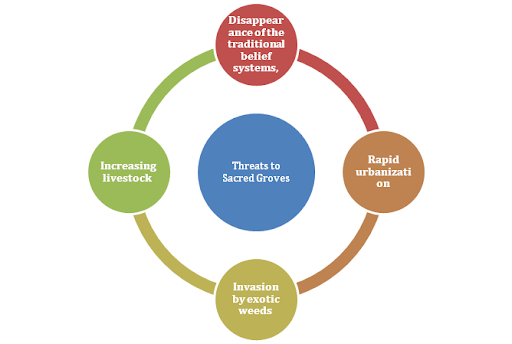Initiative to conserve sacred groves
What are sacred groves?
- Sacred groves comprise patches of forests or natural vegetation – from a few trees to forests of several acres – that are usually dedicated to local folk deities (Example – Ayyanar and Amman) or tree spirits (Vanadevatais).
- These spaces are protected by local communities because of their religious beliefs and traditional rituals that run through several generations.
- India having abundance of sacred groves, it known by several names such as kavu in Kerala, devaravana or devarakadu etc. in Karnataka, sarana or jaherthan in Jharkhand, dev van in Himachal Pradesh, devrai or devgudi in Maharashtra, ki law lyngdoh or ki law kyntang etc. in Meghalaya, vanis or kenkris etc in Rajasthan, kovilkadu in Tamil Nadu, and umanglai in Manipur.
- Himachal Pradesh has the highest number of sacred groves.
Classification
- Traditional Sacred Groves – It is the place where the village deity resides, who is represented by an elementary symbol.
- Temple Groves – Here a grove is created around a temple and conserved.
- Groves around the burial or cremation grounds.
SIGNIFICANCE
-
- Conservation of Biodiversity – The sacred groves are important repositories of floral and faunal diversity that have been conserved by local communities in a sustainable manner. They are often the last refuge of endemic species in the geographical region.
- Recharge of aquifers – The groves are often associated with ponds, streams or springs, which help meet the water requirements of the local people. The vegetative cover also helps in recharging the aquifers.
- Soil conservation – The vegetation cover of the sacred groves improves the soil stability of the area and also prevents soil erosion.
- Source of local medicine – The local tribal population rely upon some plants in the sacred groves to heal themselves.
- Carbon sink – The groves act as an effective carbon sink and are also self-sustainable ecosystem, which reinforce scientific reasons for conservation


Why in the news?
- A Puducherry based non-profit, Indigenious Biodiversity Conservation has started an initiative called ‘Uyir Moochu’ Initiative.
- Under this eco-restoration of the sacred grooves around the Puducherry and Marakkanam-Pondicherry-Cuddalore stretch is being undertaken. This area hosts around 163 sacred grooves and is home to several endemic species.
- This region belongs to Tropical Dry Evergreen Forests (TDEF) which are second most vulnerable forests after mangroves. IBF has identified 88 rare, endemic and near threatened plant species found in TDEF for conservation as part of ‘Uyir Moochu’ Initiative.
- As a part of the initiative, the organisation is collecting the seeds of the vulnerable plants of these sacred grooves and raising them in the nursery.
- The local communities are made aware about the sacred grooves and their importance, further the nursery grown plants are distributed among the communities. Their main objective is to strengthen the bond that the local communities shared with the sacred groves.
References:
- https://www.thehindu.com/news/national/tamil-nadu/initiative-to-conserve-sacred-groves/article34686374.ece
- https://www.outlookindia.com/outlooktraveller/explore/story/69898/did-you-know-sacred-groves-of-india#:~:text=Sacred%20groves%20refer%20to%20a,trees%20or%20an%20entire%20forest.
- https://www.thehindu.com/news/national/tamil-nadu/initiative-to-conserve-sacred-groves/article34686374.ece
- http://www.fao.org/3/XII/0509-A1.htm
Subscribe
Login
0 Comments
